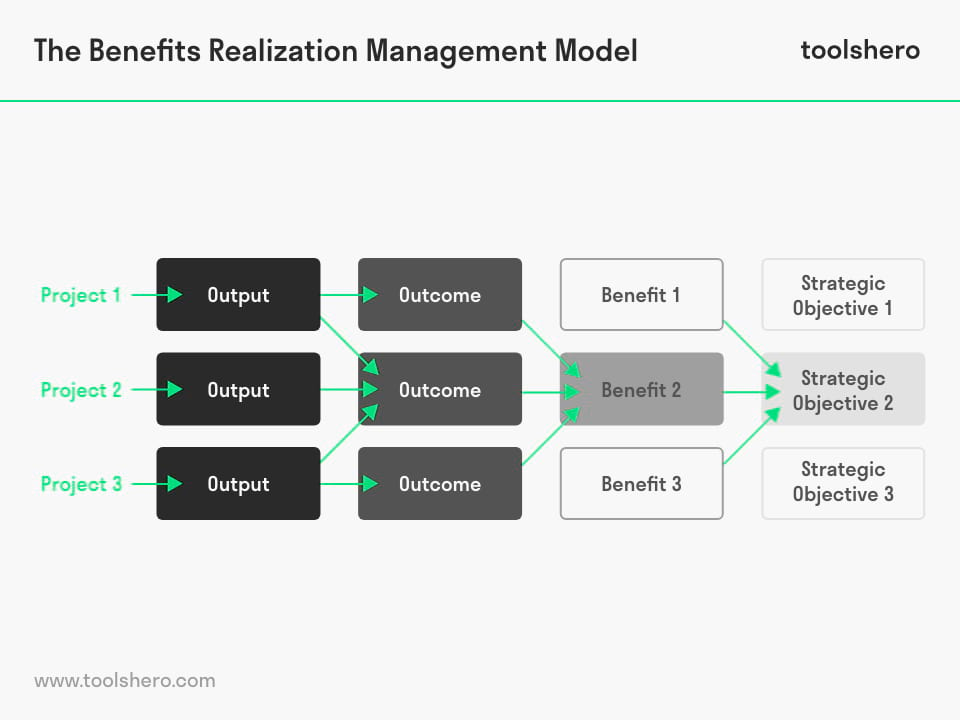Benefits Realization Management (BRM)

In this article you will find a practical explanation of Benefits Realization Management (BRM). Next to what it is, this article highlights the framework of a plan, the key components, the responsibilities in Benefits Realization Management and A practical guide. After reading, you will understand the basics of this powerful tool for optimising project resources and its benefits for business growth. Enjoy reading!
What is Benefits Realization Management (BRM)?
Time and other resources are invested in a project to achieve SMART Goals and transformational changes in organisations, for example, a product/service that is being developed and sold in the company.
Benefits Realization Management is in charge of the study of profitability and probabilities: those benefits brought by the product on which the company is working at the moment. However, it is not only about identifying profits, but also about developing improved relationships with consumers, employees and investors.
Everyone in the team or project should ask themselves the question ‘what is to be gained here’? From the people who are organising the project to the investors and the final customers, everyone can bring their unique view on the benefits of a product or service. This is how a great benefit pitch can be developed.
Everyone is looking to win, business owners or investors in projects do not buy or bet on innovative ideas unless they bring profitable benefits that are sustainable over time. These benefits are the results of an effective project, and these results are based on numbers that must be profitable, maximising ROI.
Benefits Realization Management Plan
Often, a Benefits Realization Management Plan is made that outlines how to deliver the benefits step-by-step in the project. This includes the metrics to measure the benefits, so that they can sustain the progress of the project. Elements of a Benefits Realization Management Plan are:
- Target benefits: the benefits that are expected to be realised in the end
- Coherent strategy: justification of the benefits of the project: it should benefit the organisational strategy
- Timeframe for benefits realisation: when the benefits will be realised
- Benefit owner: the person responsible for each project benefit
- Metrics: measures for benefits realisation
- Assumptions: assumptions made
- Risks: assessments of risks to project benefits and likelihood of having them and how these can be addressed if they arise
- Monitoring and reporting: processes for recording and reporting the status of benefits
You can track the process of your project with a log sheet. This visualized the changes, transformations and the fulfilment of the required benefits to achieve the optimal product or service. Use a regular table with the above mentioned elements.
Key components / framework of Benefits Realization Management
It is important to identify the objectives and improvements that need to be made to the project you are working on, hence the importance of creating an action plan to achieve your desired objectives. Once you do this, you should monitor the progress to see if the plan is working or if you need to adapt it. Also, last but not least, you should evaluate the performance of both the plan and the project itself.
In the lifespan of the project the company is working on, Benefits Realisation Management has several key components of activities to achieve success using this methodology. We will mention and break them down for you in a simple way.
Now let’s dive into the BRM components to achieve all of the above.
Identifying benefits
You must identify the benefits of the project and how it will add value to your company, thus achieving the expected results.
To do this you must execute the following activities in the project:
- Define KPIs and quantitative measures to track the benefits
- Define processes to measure the progress of the benefits realisation plan
- Create a communications plan to record and communicate in a timely manner the progress of the project to stakeholders (investors, managers, employees)
Execute benefits management
Knowing what benefits you want to have you should establish a benefits realisation plan. This plan you make will describe the activities that are essential to achieve the benefits you planned. This plan should contain a timeline that will help you monitor and review the benefits realised over time.
The implementation stage is concerned with the following activities or intermediate deliveries:
- A plan with the necessary tasks
- Execute benefits management to achieve the benefits you identified
- Know what roles and responsibilities are needed to manage the benefits
- A communications plan to provide information
- Supervise and control the project, so that everything functions in the best way according to the strategic objectives of the company
Maintain benefits realisation
- Evaluate performance to identify more benefits
This is the part of the process that happens after implementation. Deliver project deliverables to the business and take the time to evaluate how the project did. Communicate triumphs, challenges and problems and raise how these could be solved for future projects.
By communicating this with stakeholders, you will also be able to receive feedback and ideas for improvements for future projects in the company.
Responsibilities in Benefits Realization Management (BRM)
In Benefits Realization Management there will always be a leader in charge of overseeing and being in charge of all benefits realisation processes. However, not all the burden of responsibility and action lies with one person.
There are also those involved in the realisation of the benefits: the investors, the project managers, the owner(s) of the company in general, the leaders of some areas that are involved in the project, among some other employees who are essential for everything to be executed in a proper way.
If one of the people involved is no longer present for a specific reason, and another person takes over, it is essential to have Benefit Realisation Management reports from previous projects so that the new person involved can have a background on how this methodology works. This provides continuity to the processes and the achievement of objectives in the end.
Role of the Project Manager in BRM
The project manager should provide feedback after each meeting or presentation, showing an overview of how they have performed against objectives and expectations. This will help ensure that there are no surprises at the end when it comes time for performance evaluations.
This should be a two-step process. First, we need to have a project plan that describes what a person is supposed to achieve. Second, they should be evaluated against this plan.
How can Benefits Management help a company grow?
Achieving the right benefits realisation is a complex but not impossible process. The goal must be to ensure that employees are happy with the benefit options they will have and that employers and investors get the required returns on investment.
One of the ways to sustain the commitment and good performance of the people involved in Benefits Realization Management is to have a simple and clear communication strategy for the organisation’s benefits plan, giving employees easy access to information about their options and also updating them on changes and other project processes.
Maximising ROI using a well-implemented profit realisation management strategy
Most companies have turned to the benefits realisation process. That’s because they know it will help them maximise their ROI. One of the main benefits of implementing a Profit Realisation Management strategy is that it will increase customer satisfaction and increase profits.
But most companies focus on selling and are even very good at selling, but not at delivering on the promises they make to their customers. Your company should not just sell, but deliver on the promise of the product / service you are offering.

Figure 1 – Benefits Realization Management Framework and example
A practical guide to Benefits Realization Management maps
The construction of benefit maps or graphs are built from right to left, trying to achieve and visualize objectives, strategic outcomes, etc. as a starting point, then moving through the intermediate outcomes to the things needed to make them happen on the far left.
Benefits Realization Management: benefits of the dependency network (BDM)
A benefits map clearly shows how your project relates to the strategic objectives of your business. It usually includes these five sections from right to left:
Objective
Measurable end goal that supports the company’s vision.
Ultimate benefit
The reason for investing in a project or programme, the outcome that stakeholders want to see and want to gain.
Intermediate benefit
Benefits that contribute to the final benefit or put the company at an advantage.
Business changes/outcomes
Changes that need to be made or deliverables from a project that will help it achieve business objectives.
Enabler
The systems or processes that support the necessary changes and enable a business to achieve its objectives.
Benefits of the alternative dependency network (BDN)
This picture is quite similar to the benefits dependency map, but focuses on making the most of digital investments. The benefits dependency network includes these six sections from right to left:
Business drivers
The high-level drivers of change in the organisation.
Objectives
The objectives you would like to achieve that define the focus of the project.
Expected benefits
The advantages of implementing organisational changes.
Sustain organisational changes
The changes necessary to achieve the listed objectives.
Enabling organisational changes
The changes necessary to support sustainable organisational changes.
IS/IT enablers
The information systems and technology needed to support the changes necessary to achieve the intended benefits.
The first three sections define why you are making changes, the next section explains what you intend to change and the last two sections explain how you intend to get there.
Conclusion on Benefits Realization Management
The following equation can be derived from the theory on Benefits Realization Management: outputs + outcomes = benefits.
The achievement of objectives and the realization of benefits of a product or result will benefit everyone involved in the project. The project is then the process to achieve these objectives, aligned with the business strategies, will make the Benefits Realisation Management a success and add value to the company and even to the customer.
The value of each stakeholder is essential, from the internal organisational part, the employees, investors, leaders and owners of the company, to the customer, who makes it possible for the essence of the company to exist.
The steps of the process are summarized below.
- Understand the customer’s needs and wants to achieve benefits success
- Identify all benefits and how they are relevant to the customer and the overall business
- Capture the benefits in clear and concise statements
- Communicate these benefits effectively with customers and investors (everyone involved in the project)
Now It’s Your Turn
What do you think? Is the use of Benefits Realisation Management necessary for a company that wants to achieve business success? Have you used this method before? If so, tell us about your experience please? Do you have anything else to add or any suggestions?
Share your experience and knowledge in the comments box below.
More information
- Jones, P. (2021). Do your Projects Support your Strategy? Applying Benefits Realization Management.
- Love, P. E., Matthews, J., Simpson, I., Hill, A., & Olatunji, O. A. (2014). A benefits realization management building information modeling framework for asset owners. Automation in construction, 37, 1-10.
- Serra, C. E. M. (2016). Benefits realization management: Strategic value from portfolios, programs, and projects. Auerbach Publications.
How to cite this article:
Ospina Avendano, D. (2021). Benefits Realization Management (BRM). Retrieved [insert date] from toolshero: https://www.toolshero.com/project-management/benefits-realisation-management/
Original publication date: 08/09/2021 | Last update: 06/07/2023
Add a link to this page on your website:
<a href=”https://www.toolshero.com/project-management/benefits-realisation-management/”> Toolshero: Benefits Realization Management (BRM)</a>












